Preserving


Few pysanky exist today that date back to before the late 19th century. Eggshells are a fragile medium, and full eggs sometimes dry up, but sometimes leak or explode. Keeping pysanky around for a long time can be a challenge.
There is no consensus on the best way to structurally reinforce eggs for their long-term preservation. Museums and egg artists in Ukraine are using various techniques, but none have been in use long enough to judge their usefulness.
The Museum of the Pysanka in Kolomyia, a branch of the I. Korbynsky Folk Crafts Museum, uses a papier-mâché technique to preserve their pysanky. The egg is scored and cracked open, and well cleaned out.
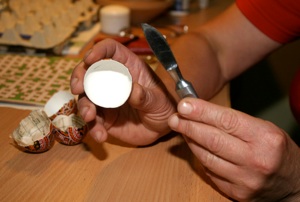
Both halves of the shell are coated with PVA glue (a white glue, similar to Elmer’s) along the interior surface, and then strips of paper (newsprint) are placed along that surface.
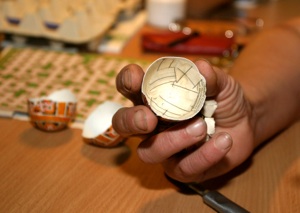
Additional strips of paper are placed in one half such that they extend out over the edge of the egg.
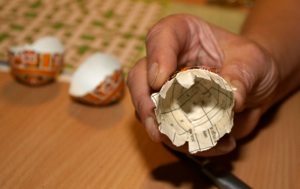
The two halves of the egg are then brought together, and approximated closely. The glue and paper will bond, and the cracked edge will be almost invisible.
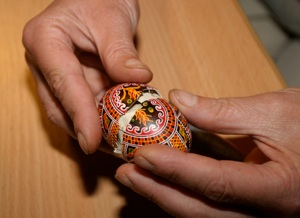
A video demonstration of the technique can be see here. (And more photos here.)
CAUTION: Many pysankary and others have expressed concerns about this method of preservation. The paper used is ordinary newsprint, and not archival acid-free paper; it is not known how long such paper will hold up, and what sort of damage the acid might cause over time. Additionally, rather than limiting this technique to new pysanky, it has been used on much older eggs in the museum’s collection, many of which had survived decades without harm (and several of which were damaged in the process). When perusing the displays, one can often see the damage done in the pysanky on display, including visible cracks and missing areas of shell.
I have been told of several other techniques used to preserve eggs. Several of the beaded pysanky I bought seemed unusually heavy; I was told they had been reinforced with glue and a fine grain (farina?), while others had been filled with a layer of some sort of cement.
One method that used to be fairly common, but seems to have gone by the wayside, is preserving eggs by filling them with beeswax. The egg would be blown out, rinsed, and then molten beeswax poured through a small hole to fill the egg. This method is potentially a useful one, as long as the egg is kept in a climate controlled, vermin free environment. Why?
A friend of mine who’d used this technique told me why he’d quit using it. First of all, because of temperature variation, the beeswax in many of his eggs expanded greatly, cracking them thusly:
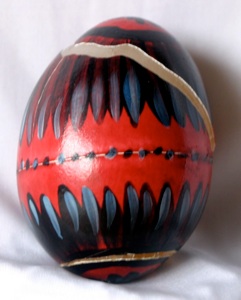
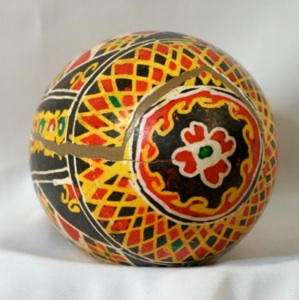
Other eggs were damaged when mice, smelling the beeswax, chewed through the cartons he stored the eggs in, and then gnawed at the eggs themselves to get at the beeswax:

He now empties the eggs, cleans them out thoroughly, and glues them carefully back together. (Because the eggs are not fresh when he buys them, simply blowing out the contents isn’t really an option.) He coats the interiors with a layer of PVA (white glue), and puts a coat of Damar varnish on the exterior. (Damar varnish is used by artists to finish oil paintings. It has a golden patina when aged.) He has been doing this for several decades; once again, this is not quite long enough to know if this will produce archival results.
I have done none of this with my eggs. I try to write my pysanky and eggs with good, thick shells, and empty them, rinsing well, soon after writing. I put at least one coat of clear polyurethane varnish on the egg, and keep it out of sunlight. And that’s it. None of my pysanky have fallen apart, but then, the oldest among them only date back to the seventies.
Back to Main Finishing page
Back to Main Pysankarstvo page
Search my site with Google
Reinforcing Eggshells


